HTC Thunderbolt Review: The First Verizon 4G LTE Smartphone
by Brian Klug on April 27, 2011 12:12 AM EST- Posted in
- Smartphones
- HTC
- Verizon
- LTE
- 4G
- Android
- HTC Thunderbolt
- Mobile
- MDM9600
- MSM8655
So how much does 4G LTE affect battery life? Now is as good a time as ever to segue into battery results for the Thunderbolt. Unfortunately things here don’t paint a good picture for LTE and smartphone battery life.
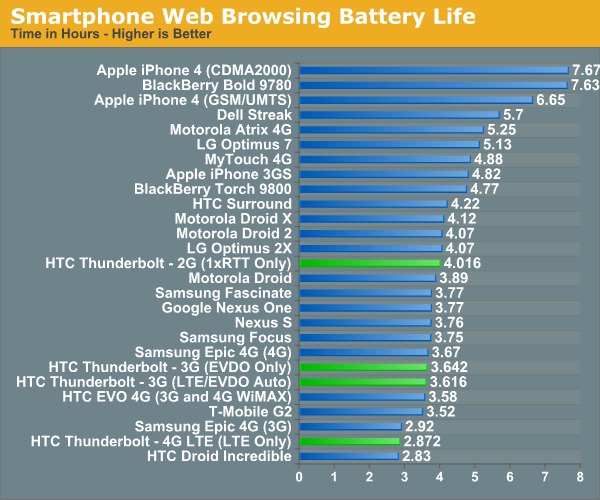

I ran four tests on the Thunderbolt. Again this is our standard smartphone battery life test, with the display set to 50% brightness always on, loading our page load suite until the battery dies. In LTE only mode I ensured the phone stuck on LTE coverage in a good coverage area. I also did tests on both EVDO (3G) and 1xRTT (2G) only to illustrate the difference those make. Lastly, there’s been a persistent rumor for some time that allowing the modem to periodically search for LTE (like you would in the default “CDMA + EVDO/LTE auto” mode) negatively impacts 3G battery life. I ran a test with it in this auto mode and EVDO only to illustrate that the MDM9600 searching periodically doesn’t really affect battery life to an appreciable amount. Remember that 3-5 minute handover time? It’s clear that the polling index is sufficiently infrequent that this isn’t a big problem.
In a 4G LTE market, the Thunderbolt does drain pretty fast. I think it speaks volumes that Verizon stores are stocking a first party 2750 mAh extended battery and cover. That’s almost exactly double the size of the Thunderbolt’s default 1400 mAh battery. I didn’t get to play with the extended battery or inductive charging door that comes with it, but expect it to double battery life numbers.
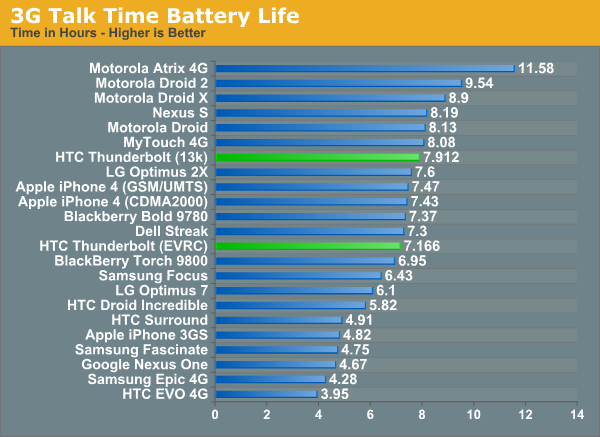
The two other tests we usually run are the same as ever, though I did something interesting on the Thunderbolt by running with two different vocoders set. CDMA2000 phones are interesting since most of the Qualcomm enabled devices come with EPST, which lets you switch between EVRC, EVRC-B, and QCELP 13k. There’s a subtle but detectable difference in audio quality between the three, but even then lot of that is still subjective. EVRC supports bitrates of 8.55, 4.0, and 0.8 kbps, while EVRC-B builds upon this with some better silence and noise coding, in addition to offering a quarter rate, 2.0 kbps for better QoS. In newer phones and networks, EVRC is far and away the most common (default for the Thunderbolt as well), with EVRC-B an up and coming second.

Though EVRC and EVRC-B definitively offer better quality per bitrate (which helps carriers pack more voice capacity on the network), there’s another option that improves voice quality further. QCELP is an older voice coder, but allows for 13.3, 6.2, 2.7, 1.0 kbps streams. In theory, QCELP 13k can offer better voice quality in good coverage areas and network conditions. Carriers have moved away from QCELP to EVRC again for the implicit purpose of supporting more voice capacity with the same amount of bandwidth.
Interestingly enough, battery life does change subtly between 13k and EVRC on the Thunderbolt. I was somewhat surprised to see things swing this way, considering that EVRC is a more complicated codec than QCELP, and thus requires slightly more instructions per frame. It’s possible that at my test location, the Thunderbolt on QCELP negotiates a lower bandwidth stream than EVRC, and thus we see less data transacted.
Whether or not you can distinguish the differences between the three vocoders depends on a variety of factors. It’s undeniable however that EVRC-B doesn’t have the potential to sound better than EVRC in some conditions due to the presence of a quarter bitrate mode, and 13k even better still. I’ve taken audio recordings of the Thunderbolt calling the local weather ASOS and recorded output both using the line out jack. I also recorded two using a Blue Yeti microphone with the Thunderbolt kickstand open and closed to give a feeling for how different sound is in both configurations.
Voice Coder Comparison
HTC Thunderbolt - Headphone - 13k by AnandTech
HTC Thunderbolt - Headphone - 13k IS733 by AnandTech
HTC Thunderbolt - Headphone - EVRC by AnandTech
HTC Thunderbolt - Headphone - EVRC-B by AnandTech
Kickstand Comparison
HTC Thunderbolt EVRC Kickstand Closed by AnandTech
HTC Thunderbolt EVRC Kickstand Open by AnandTech
WiFi Hotspot
Like every Android phone, the Thunderbolt also includes phone as WiFi hotspot functionality. It’s the same HTC app we’ve seen before bundled with HTC sense, except this time the phone is on LTE. There have been a number of complaints about the Thunderbolt switching back and forth between EVDO and LTE and completely suspending WiFi connections during handover. This is more of a software problem that HTC should be able to fix by tweaking their hotspot software. Again the LTE handovers seem to briefly break connectivity, and the 4G status indicator briefly goes away. The HTC hotspot software as a result thinks the connection has been lost entirely, and suspends or drops WiFi connections. For now, the problems can be mitigated somewhat by forcing LTE only, and while I didn’t encounter any deal breaking instability this is something that can definitely be fixed with better AP management software.
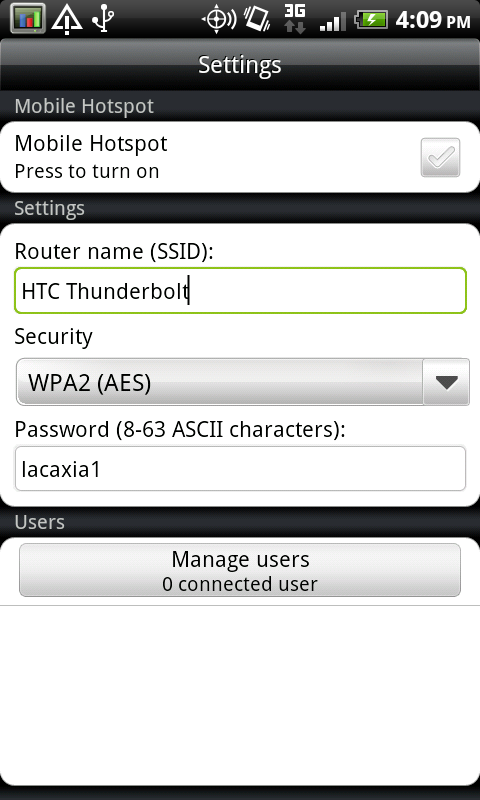
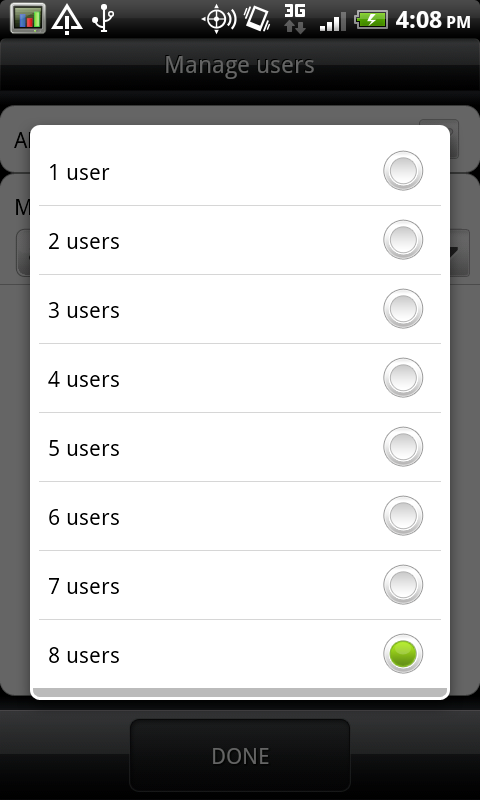
The Thunderbolt ships by default with the hotspot only set to allow 5 users to connect. Dig into the menus, and you can easily change this to 8. Eight seems a bit arbitrary (as do all of these limitations, at this rate), but it’s there if you want it. Apparently some other LTE phones coming out will enable 10. If that’s seriously a deal-making feature, I think something is wrong. Just make it 10 everywhere, especially if it’s the same exact cellular modem.
For a while now, I’ve been secretly (well, not really secretly) running a fourth test on phones and wireless devices to measure WiFi hotspot battery life. Historically, WiFi tethering has been brutal on battery life, and I devised a test that I think is reasonably representative. For this test, I have two tabs of our standard page load test, and another two with flash, for a total of four tabs loading through a few dozen pages every 10 seconds. In addition, I have a 128 kbps MP3 audio stream from smoothbeats.com playing in the background to keep data active constantly. There’s just one wireless client with a 802.11n WiFi card connected, though all this traffic reasonably approximates a few wireless clients all transacting data.
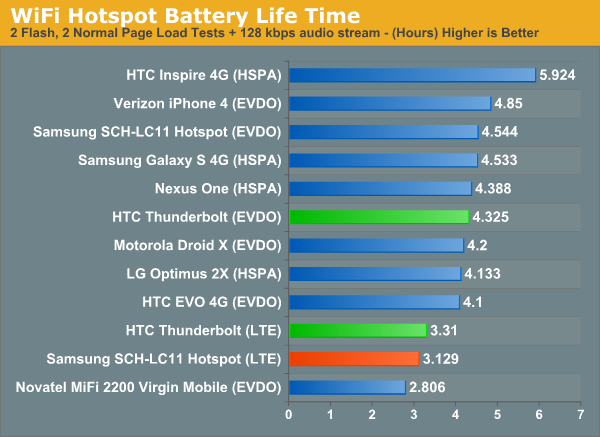
The results here are interesting, and the Thunderbolt actually doesn’t do too bad, actually besting the standalone LTE enabled Samsung hotspot. Unsurprisingly, EVDO battery life is right where it should be at just over 4 hours. LTE data on Verizon is unlimited as of this writing, though that’s sure to change soon. If you can get it, the Thunderbolt certainly is a viable way to connect to the internet pretty speedily.

WiFi throughput on the Thunderbolt is class leading. I was impressed by its performance in our test, which consists of loading a 100 MB PDF over the network. I saw brief spikes over this average result.
WiFi performance on the Thunderbolt I guess actually is a bit of a surprise. I guess it shouldn’t be a huge surprise that the the smartphone with the best overall connectivity also delivers in the WiFi department. The Thunderbolt pairs at the same 72 Mbps we’ve seen before with 802.11b/g/n. Sadly, no 5 GHz 802.11a/n is present. I seriously hope 5 GHz support starts showing up in more smartphones going forward, because it really is impossible to reliably use 2.4 GHz anything at trade shows. Range on the Thunderbolt is right where it should be, though a tiny bit better than the Desire HD/Inspire 4G.










71 Comments
View All Comments
cmdrdredd - Thursday, April 28, 2011 - link
Or if you're stuck on an old android phone that has no memory, hardly any cpu or gpu power, and bogs down heavily all the time thanks to the new OS revisions not being highly optimized for slower phones (no upgrade path even for some too), and you decided you don't want to be a slave to Apple and what they decide you can and cannot have/do with the device, you might look at this for your upgrade if you were itching right now. Why wait for June to see the new Droid Bionic when you need a phone now that works properly and is faster?deputc26 - Wednesday, April 27, 2011 - link
Now THIS is a smartphone review. This is the meticulous quantitative data that I keep coming back to Anandtech for. Would like to see real world load times of real web sites though.7Enigma - Wednesday, April 27, 2011 - link
Seconded. I'm not a huge fan of smartphones (I don't own one and normally just skim the reviews for hardware/OS information) but this one reminded me of old-school Anandtech. Nitty-gritty detail and substance that anyone can tell required a LONG time to write.And factoring in the legitimate excuse of being ill made it all the more impressive.
Great job again Brian.
kurt-o - Wednesday, April 27, 2011 - link
The article stated "Remember that although the HTC EVO 4G could have conceivably supported simultaneous 4G WiMAX and 1x voice, the feature was disabled and to my knowledge hasn’t ever been enabled. It’s for this reason - until the Thunderbolt no proper procedure for characterizing dual transceiver phones existed."Unless I'm confused here, the article appears to have a blatant error. The HTC EVO 4G supports simultaneous 4G WiMAX and 1x-Voice. Has since day 1.
metafor - Wednesday, April 27, 2011 - link
I think what's meant is that it can't do simultaneous voice and data over 3G, which is true. If you are in a 4G area, I believe the Evo can use WiMax for data and 3G for voice.Brian Klug - Wednesday, April 27, 2011 - link
Are you certain? Although I have an EVO I'm not in a WiMAX market, so I can't test for certain. I know that WiFi + 1x voice is a definite go, 1x voice + EVDO is a no, but I was under the impression again that 1x voice + WiMAX is also a no.From the user manual:
"Can I make calls and use data services at the same time?
You cannot use voice and data services simultaneously. If you receive a call while data service is active, your device forwards the call to voicemail. You can place an outgoing call anytime, but it will interrupt any in-progress data session."
-Brian
privater - Wednesday, April 27, 2011 - link
Does this phone have a nuclear battery as accessory?ompaidjo - Tuesday, May 3, 2011 - link
:DI kept thinking about the same thing, since I bought this phone..
strikeback03 - Tuesday, May 3, 2011 - link
It isn't great, but then again I'd say that if you need several hours of web browsing time per charge a smartphone is probably not the right device for you anyway.ltcommanderdata - Wednesday, April 27, 2011 - link
4G brings better speed for the end user, but sometimes I wonder if I'd be more worthwhile to invest instead in existing 3G infrastructure to ensure wide area, consistent 3G coverage at the upper speed spec of 3G rather than focus on 4G peak speeds in some areas. I guess 4G is more worthwhile on CDMA networks where the speed disparity is greater than on GSM networks where up to 14Mbps HSPA vs LTE isn't as big a difference in usability.On an unrelated note, your benchmark charts don't seem to include the updated iOS 4.3 results that say the previous Dell Venue Pro review had. The updated browser in iOS 4.3 compared to iOS 4.2 makes a material difference in the benchmarks.